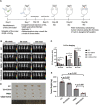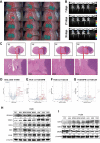PROTAC EZH2 degrader-1 overcomes the resistance of podophyllotoxin derivatives in refractory small cell lung cancer with leptomeningeal metastasis
- PMID: 38644473
- PMCID: PMC11034131
- DOI: 10.1186/s12885-024-12244-3
PROTAC EZH2 degrader-1 overcomes the resistance of podophyllotoxin derivatives in refractory small cell lung cancer with leptomeningeal metastasis
Abstract
Background: Leptomeningeal metastasis (LM) of small cell lung cancer (SCLC) is a highly detrimental occurrence associated with severe neurological disorders, lacking effective treatment currently. Proteolysis-targeting chimeric molecules (PROTACs) may provide new therapeutic avenues for treatment of podophyllotoxin derivatives-resistant SCLC with LM, warranting further exploration.
Methods: The SCLC cell line H128 expressing luciferase were mutated by MNNG to generate H128-Mut cell line. After subcutaneous inoculation of H128-Mut into nude mice, H128-LM and H128-BPM (brain parenchymal metastasis) cell lines were primarily cultured from LM and BPM tissues individually, and employed to in vitro drug testing. The SCLC-LM mouse model was established by inoculating H128-LM into nude mice via carotid artery and subjected to in vivo drug testing. RNA-seq and immunoblotting were conducted to uncover the molecular targets for LM.
Results: The SCLC-LM mouse model was successfully established, confirmed by in vivo live imaging and histological examination. The upregulated genes included EZH2, SLC44A4, VEGFA, etc. in both BPM and LM cells, while SLC44A4 was particularly upregulated in LM cells. When combined with PROTAC EZH2 degrader-1, the drug sensitivity of cisplatin, etoposide (VP16), and teniposide (VM26) for H128-LM was significantly increased in vitro. The in vivo drug trials with SCLC-LM mouse model demonstrated that PROTAC EZH2 degrader-1 plus VM26 or cisplatin/ VP16 inhibited H128-LM tumour significantly compared to VM26 or cisplatin/ VP16 alone (P < 0.01).
Conclusion: The SCLC-LM model effectively simulates the pathophysiological process of SCLC metastasis to the leptomeninges. PROTAC EZH2 degrader-1 overcomes chemoresistance in SCLC, suggesting its potential therapeutic value for SCLC LM.
Keywords: Chemoresistance; Leptomeningeal metastases; Mouse model; PROTAC EZH2 degrader-1; Small cell lung cancer.
© 2024. The Author(s).
Conflict of interest statement
Not applicable.
Figures





Similar articles
-
Poly (ADP) ribose polymerase enzyme inhibitor, veliparib, potentiates chemotherapy and radiation in vitro and in vivo in small cell lung cancer.Cancer Med. 2014 Dec;3(6):1579-94. doi: 10.1002/cam4.317. Epub 2014 Aug 13. Cancer Med. 2014. PMID: 25124282 Free PMC article.
-
CDYL promotes the chemoresistance of small cell lung cancer by regulating H3K27 trimethylation at the CDKN1C promoter.Theranostics. 2019 Jul 9;9(16):4717-4729. doi: 10.7150/thno.33680. eCollection 2019. Theranostics. 2019. PMID: 31367252 Free PMC article.
-
Overcoming multi-drug resistance in SCLC: a synergistic approach with venetoclax and hydroxychloroquine targeting the lncRNA LYPLAL1-DT/BCL2/BECN1 pathway.Mol Cancer. 2024 Oct 31;23(1):243. doi: 10.1186/s12943-024-02145-1. Mol Cancer. 2024. PMID: 39478582 Free PMC article.
-
Bromodomain Protein-directed Agents and MYC in Small Cell Lung Cancer.Curr Cancer Drug Targets. 2024;24(9):930-940. doi: 10.2174/0115680096272757231211113206. Curr Cancer Drug Targets. 2024. PMID: 38275056 Review.
-
Small Cell Lung Cancer Neuronal Features and Their Implications for Tumor Progression, Metastasis, and Therapy.Mol Cancer Res. 2024 Sep 4;22(9):787-795. doi: 10.1158/1541-7786.MCR-24-0265. Mol Cancer Res. 2024. PMID: 38912893 Free PMC article. Review.
Cited by
-
Redefining the Fight Against SCLC: Standards, Innovations, and New Horizons.Cancers (Basel). 2025 Jul 7;17(13):2256. doi: 10.3390/cancers17132256. Cancers (Basel). 2025. PMID: 40647553 Free PMC article. Review.
-
Targeting EZH2 in Cancer: Mechanisms, Pathways, and Therapeutic Potential.Molecules. 2024 Dec 10;29(24):5817. doi: 10.3390/molecules29245817. Molecules. 2024. PMID: 39769907 Free PMC article. Review.
-
Navigating PROTACs in Cancer Therapy: Advancements, Challenges, and Future Horizons.Food Sci Nutr. 2025 Feb 1;13(2):e70011. doi: 10.1002/fsn3.70011. eCollection 2025 Feb. Food Sci Nutr. 2025. PMID: 39898116 Free PMC article. Review.
-
Beyond the brain: exploring the impact of animal models of leptomeningeal disease from solid tumors.Acta Neuropathol Commun. 2025 May 19;13(1):103. doi: 10.1186/s40478-025-01959-4. Acta Neuropathol Commun. 2025. PMID: 40383789 Free PMC article. Review.
References
-
- IARC. World Cancer Report: Cancer Research for Cancer Prevention. 2020 [cited 2020; https://publications.iarc.fr/Non-Series-Publications/World-Cancer-Report...
MeSH terms
Substances
LinkOut - more resources
Full Text Sources
Medical

